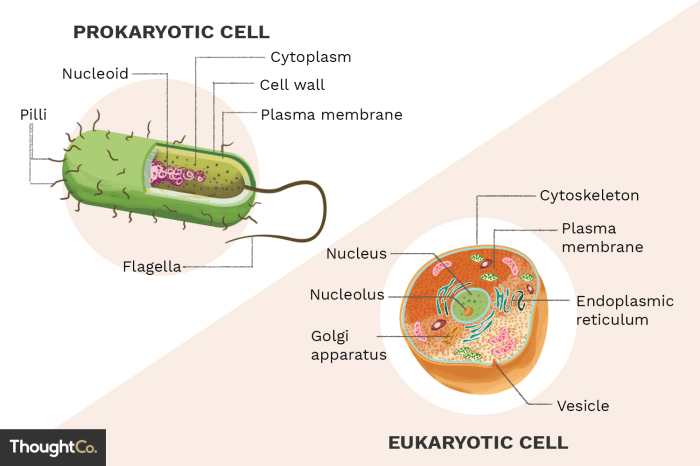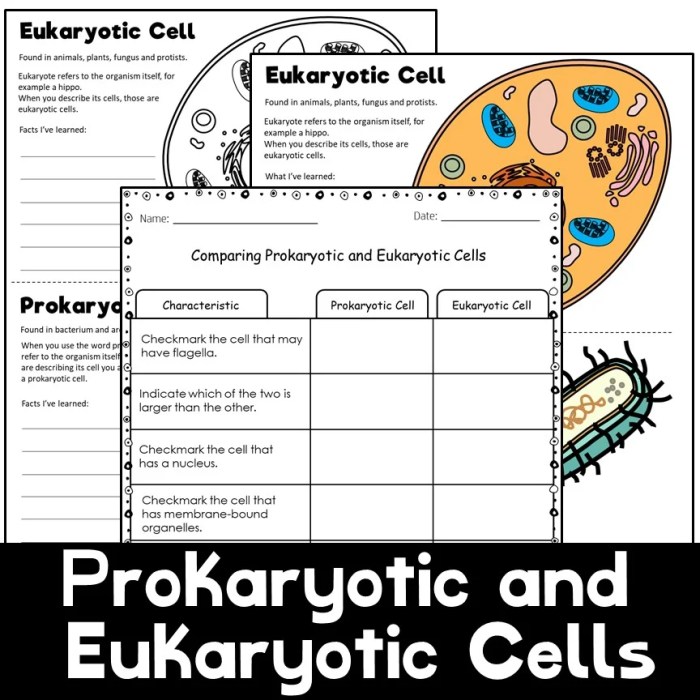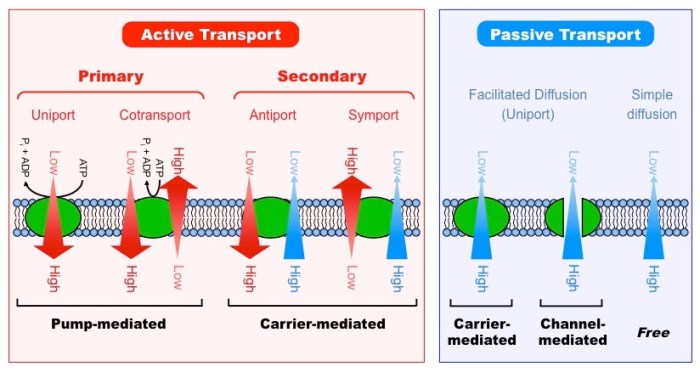Embark on an educational journey with our Prokaryote and Eukaryote Cells Worksheet, a comprehensive resource designed to unravel the intricate complexities of these fundamental units of life. Delve into the distinct characteristics, structures, functions, and evolutionary relationships that define these two cell types, gaining a deeper appreciation for the diversity and complexity of life’s building blocks.
Throughout this worksheet, you will explore the fundamental differences between prokaryotic and eukaryotic cells, delving into their unique cellular structures, metabolic processes, and reproductive mechanisms. Discover the evolutionary origins of eukaryotic cells and their profound impact on the evolution of life on Earth.
This worksheet is an indispensable tool for students, educators, and anyone seeking to expand their understanding of cell biology.
Introduction

Cells are the fundamental units of life. They are the basic building blocks of all living things, and they carry out all of the functions necessary for life. There are two main types of cells: prokaryotic and eukaryotic cells. Prokaryotic cells are the simplest type of cells, and they are found in bacteria and archaea.
Eukaryotic cells are more complex than prokaryotic cells, and they are found in all other living things, including plants, animals, and fungi.
Cell Structure
The main difference between prokaryotic and eukaryotic cells is their structure. Prokaryotic cells are much smaller than eukaryotic cells, and they do not have a nucleus or any other membrane-bound organelles. Eukaryotic cells have a nucleus and many other membrane-bound organelles, including the endoplasmic reticulum, Golgi apparatus, and mitochondria.
The following table summarizes the key differences between prokaryotic and eukaryotic cells:
| Cell Structure | Prokaryotic Cells | Eukaryotic Cells |
|---|---|---|
| Size | 0.1-5.0 µm | 10-100 µm |
| Nucleus | No | Yes |
| Membrane-bound organelles | No | Yes |
Cell Function

Prokaryotic and eukaryotic cells carry out many of the same functions, such as metabolism, growth, and reproduction. However, there are some key differences in the way that these cells carry out these functions.
Prokaryotic cells are able to carry out all of their functions in the cytoplasm. Eukaryotic cells, on the other hand, have specialized organelles that carry out specific functions. For example, the mitochondria are responsible for producing energy, and the endoplasmic reticulum is responsible for synthesizing proteins.
Cell Reproduction: Prokaryote And Eukaryote Cells Worksheet

Prokaryotic and eukaryotic cells also reproduce in different ways. Prokaryotic cells reproduce by binary fission, which is a simple process that involves the cell dividing into two identical daughter cells. Eukaryotic cells reproduce by mitosis, which is a more complex process that involves the cell dividing into two daughter cells that are genetically identical to the parent cell.
Cell Evolution

The evolutionary relationship between prokaryotic and eukaryotic cells is not fully understood. However, it is thought that eukaryotic cells evolved from prokaryotic cells through a process called endosymbiosis. Endosymbiosis is the process by which one cell engulfs another cell and the two cells become one.
It is thought that the mitochondria and chloroplasts in eukaryotic cells were once free-living prokaryotic cells that were engulfed by eukaryotic cells.
Applications in Biotechnology
Prokaryotic and eukaryotic cells are both used in biotechnology. Prokaryotic cells are often used to produce antibiotics and other drugs. Eukaryotic cells are often used to produce proteins and other biomolecules.
The following are some examples of how prokaryotic and eukaryotic cells are used in biotechnology:
- Prokaryotic cells are used to produce antibiotics, such as penicillin and streptomycin.
- Prokaryotic cells are used to produce other drugs, such as insulin and human growth hormone.
- Eukaryotic cells are used to produce proteins, such as antibodies and enzymes.
- Eukaryotic cells are used to produce other biomolecules, such as vaccines and gene therapy products.
Common Queries
What are the key differences between prokaryotic and eukaryotic cells?
Prokaryotic cells lack a nucleus and other membrane-bound organelles, while eukaryotic cells possess a true nucleus and a variety of membrane-bound organelles.
How do prokaryotic and eukaryotic cells reproduce?
Prokaryotic cells reproduce through binary fission, while eukaryotic cells reproduce through mitosis or meiosis.
What are some examples of prokaryotic and eukaryotic cells?
Examples of prokaryotic cells include bacteria and archaea, while examples of eukaryotic cells include plants, animals, fungi, and protists.
How are prokaryotic and eukaryotic cells used in biotechnology?
Prokaryotic cells are used in the production of antibiotics and other pharmaceuticals, while eukaryotic cells are used in the production of vaccines and other biological products.


